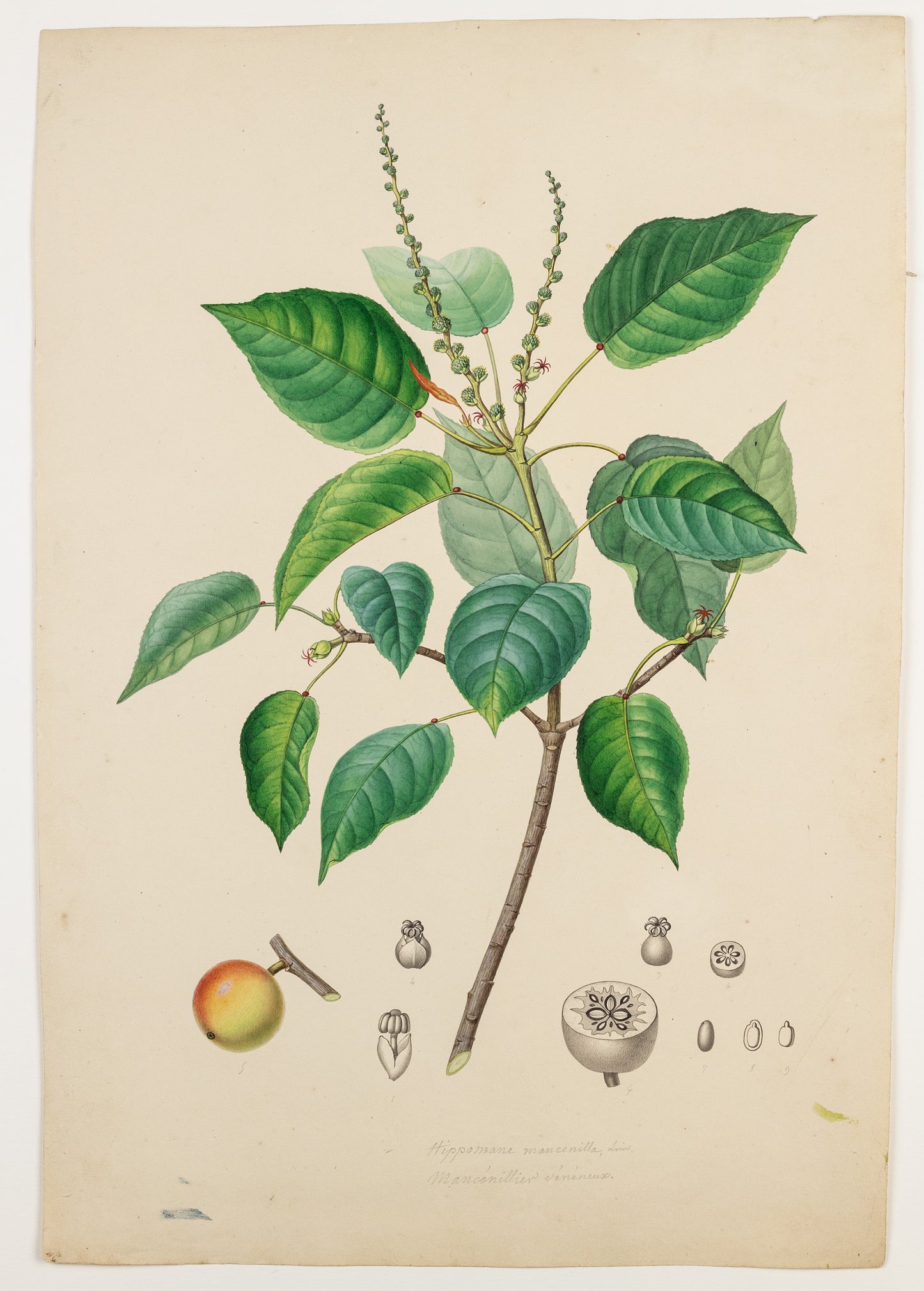from: Poiteau & Turpin Superb Botanical Drawings including varieties from the West Indies
PIERRE JEAN FRANÇOIS TURPIN (FRENCH, 1775–1840). The manchineel tree.
PIERRE JEAN FRANÇOIS TURPIN (FRENCH, 1775–1840). The manchineel tree.
Couldn't load pickup availability
PIERRE JEAN FRANÇOIS TURPIN (FRENCH, 1775–1840)
“Mancinella venenata The Mangeneel Tree”
(The manchineel tree [Hippomane mancinella])
Preparatory drawing for F.R. Tussac, Flore des Antilles, ou histoire générale botanique, rurale et economique des végétaux indigènes des Antilles. Paris: chez l’auteur, F. Schoell et Hautel, 1808–1827. Vol. 3, Pl. 13
Watercolor and pencil on paper
Paper size:
The manchineel tree, often referred to as manchioneel or manchineal, has a name that originates from the Spanish term “manzanilla,” which translates to ‘little apple.’ This name stems from the tree’s small, round fruit and its lush green leaves, both of which bear a resemblance to those of an apple tree. Commonly known as the beach apple, this tree thrives in coastal areas. A strikingly cautionary name in contemporary Spanish is “manzanilla de la Muerte,” or ‘little apple of death.’ This ominous title underscores the extreme toxicity of the manchineel, making it one of the most dangerous trees in the world. All parts of the plant, from its sap to its fruit, carry potent toxins that can cause serious harm to humans and animals alike.
Tussac addressed the dichotomy of this tree, noting the deadly attributes belie its seemingly innocuous appearance. Writing:
“Although nature in its productions appears to us to follow a constant and uniform course, there are nevertheless occasions when it seems to deviate from this law: the limits of our knowledge do not allow us to guess the intention of these supposed deviations. Jealous of the preservation of living beings endowed with sensitivity and reason, this common mother ordinarily imprints on poisonous plants the seal of reprobation, by dominating them with a repulsive aspect; flowers whose dull, ignoble colors affect the eyes in an unpleasant manner; often they let escape emanations which, by forming around them an infected atmosphere, drive away not only beings endowed with reason, but also those who are directed by that feeling that we call instinct, which is often more certain than our intelligence.
The manchineel tree provides us with an example of the kinds of aberrations that I want to point out. We find gathered in this perfidious plant everything that can contribute to attracting to it those who are not insensitive to the charms of nature; an elegant bearing, bushy foliage of a pleasant green, through which emerge wonderfully a large quantity of fruits of a pretty shape, colored a greenish yellow on one side, and a rather lively crimson on the other; they seem to offer the thirsty traveler a refreshment that the burning heat of the climate makes him ardently desire.
Imprudent traveler, stop! stop! Death would follow closely your indiscreet approach.
The manchineel is one of the most famous trees of the Antilles, not for its good qualities, for it has only bad ones; it has not even that which all botanists, copying one another, attribute to it, of furnishing a compact wood, capable of taking a beautiful polish, and veined with different colors: the rarity of this tree that the government wisely ordered to be destroyed everywhere where it was found; this is without doubt the cause which has led botanists to prefer to refer to their predecessors, rather than to see and instruct themselves; it is thus that a century transmits to posterity the errors of preceding centuries, and that one sets limits to the progress of Science.
The wood of the manchineel tree is a very white wood, very soft, stringy, which according to this is not fit for anything, not even to burn, because the smoke which comes out of it, besides being dangerous to breathe, crosses the thickness of the vases, even of iron, in which one cooks some dishes, and poisons them.
I have had the occasion to observe this poisonous tree in Saint-Domingue, in the district of Arcahaye, on the Merot plantation, in a wood which is located at the seaside; several people living on this plantation, having eaten crabs which had been taken in the wood which I have just spoken of, were poisoned; it was easily assumed that the cause of this poisoning was the crabs, which had eaten manchineel fruit, the wood was searched, and two feet of this dangerous tree were found on the seaside; for then having acquired the certainty of the nature of the poison, all those who were infected with it were made to swallow sea water, which is the best antidote to this pernicious plant, they were all saved.
If one were too far from the sea, one could substitute water in which one dissolved a good quantity of table salt, but one is never very far from the sea in the case of poisoning by the manchineel tree, because this tree only grows on its shores, or in the salt marshes which are always near it. The remedy is therefore found alongside the evil…
It is said for certain in the Antilles that a traveler who has the misfortune to fall asleep under a manchineel tree never wakes up again.”

Appeared in F.R. Tussac, Flore des Antilles, ou histoire générale botanique, rurale et economique des végétaux indigènes des Antilles. Paris: chez l’auteur, F. Schoell et Hautel, 1808–1827, study for Vol. 3, Plate 5


